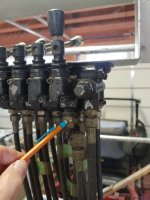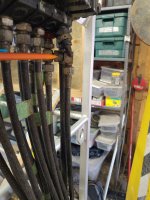oldnslo
Super Member
Beez,
In reviewing schematic again and thinking about this further I am still puzzled on where the external pressure is coming from to extend the cage cylinder.
While manually extending with ratchet strap you could potentially pressurize the rod of both cylinders if the over centervalve is opened. This would then allow a slightly larger volume of oil to pressurized since the knuckle cylinder is in the fully extend position while you were doing this. Pressurizing the rod ends should keep the cage from extending but crazy thought if the seals on the knuckle cylinder are leaking slightly could you have also induced some pressure into the cap end of the knuckle cylinder? If yes then this pressure would extend the cage cylinder since would have free flow through the PO check and if high enough to over come the over center valve setting. Any trapped air would also act like an accumulator to increase potential flow.
Problem is this really doesn't work when you tried retracting the cage cylinder with the ratchet strap.
A bad seal on the cage cylinder and I would think you could extend the cylinder fully with the ratchet strap.
Back to thinking we need gauges in the system. Since closed system be nice to have one in both the rod and cap end lines so can observe what is happening. Problem how to do this with introducing more air or in a location where the air cab be purged easily or easier.
Can you safely operate the cage tilt cylinder fully with the mast fully raised? I.e. knuckle cylinder fully retracted. Just curious is this would help remove any potential trapped air in cap end since it should be forced out to the cage cylinder.
In reviewing schematic again and thinking about this further I am still puzzled on where the external pressure is coming from to extend the cage cylinder.
While manually extending with ratchet strap you could potentially pressurize the rod of both cylinders if the over centervalve is opened. This would then allow a slightly larger volume of oil to pressurized since the knuckle cylinder is in the fully extend position while you were doing this. Pressurizing the rod ends should keep the cage from extending but crazy thought if the seals on the knuckle cylinder are leaking slightly could you have also induced some pressure into the cap end of the knuckle cylinder? If yes then this pressure would extend the cage cylinder since would have free flow through the PO check and if high enough to over come the over center valve setting. Any trapped air would also act like an accumulator to increase potential flow.
Problem is this really doesn't work when you tried retracting the cage cylinder with the ratchet strap.
A bad seal on the cage cylinder and I would think you could extend the cylinder fully with the ratchet strap.
Back to thinking we need gauges in the system. Since closed system be nice to have one in both the rod and cap end lines so can observe what is happening. Problem how to do this with introducing more air or in a location where the air cab be purged easily or easier.
Can you safely operate the cage tilt cylinder fully with the mast fully raised? I.e. knuckle cylinder fully retracted. Just curious is this would help remove any potential trapped air in cap end since it should be forced out to the cage cylinder.



